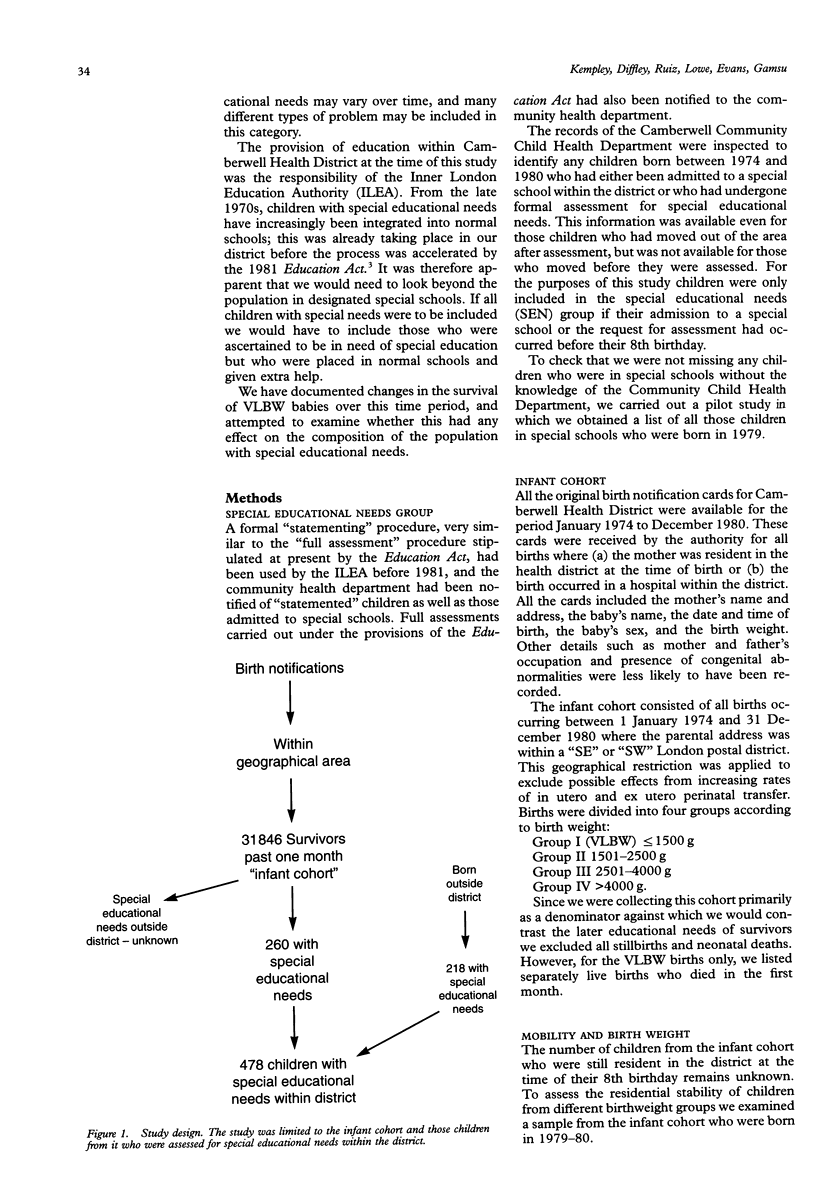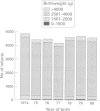Abstract
OBJECTIVES--To assess the contribution of children with different birth weights to special educational needs within a single health district, and to determine whether this pattern changed over the time when the survival of very low birthweight (VLBW) infants was increasing. SETTING--An inner London health district. STUDY DESIGN--A cohort of children born to local parents between January 1974 and December 1980 was selected from birth notifications, including only those infants who survived for more than one month. Community child health records were then inspected to identify children from the cohort who had been formally assessed for special educational needs before their 8th birthday. The risk of special educational needs was compared for the years 1974-77 and 1977-80 (the first and second halves of the period studied). SUBJECTS--The infant cohort consisted of 31,846 children. Altogether 260 (0.8%) of these were later assessed formally. RESULTS--VLBW infants were 4.4 times more likely to be assessed than normal birthweight infants. Formal assessment within the district occurred in three of 68 VLBW infants from the first half of the period studied, and three of 120 from the second half. CONCLUSION--Although VLBW infants are at higher risk, an increase in their survival was not associated with any increase in their contribution to the group with special educational needs within our district. Their contribution, as a group, to the total number of children with special educational needs is very small.
Full text
PDF




Images in this article
Selected References
These references are in PubMed. This may not be the complete list of references from this article.
- Alberman E., Benson J., McDonald A. Cerebral palsy and severe educational subnormality in low-birthweight children: a comparison of births in 1951-53 and 1970-73. Lancet. 1982 Mar 13;1(8272):606–608. doi: 10.1016/s0140-6736(82)91759-7. [DOI] [PubMed] [Google Scholar]
- Cohen S. E., Parmelee A. H. Prediction of five-year Stanford-Binet scores in preterm infants. Child Dev. 1983 Oct;54(5):1242–1253. [PubMed] [Google Scholar]
- Maddock C. R. A population-based evaluation of sustained mechanical ventilation of newborn babies. Lancet. 1987 Nov 28;2(8570):1254–1258. doi: 10.1016/s0140-6736(87)91862-9. [DOI] [PubMed] [Google Scholar]
- Ornstein M., Ohlsson A., Edmonds J., Asztalos E. Neonatal follow-up of very low birthweight/extremely low birthweight infants to school age: a critical overview. Acta Paediatr Scand. 1991 Aug-Sep;80(8-9):741–748. doi: 10.1111/j.1651-2227.1991.tb11943.x. [DOI] [PubMed] [Google Scholar]
- Pharoah P. O., Stevenson R. C., Cooke R. W., Sandu B. Costs and benefits of neonatal intensive care. Arch Dis Child. 1988 Jul;63(7 Spec No):715–718. doi: 10.1136/adc.63.7_spec_no.715. [DOI] [PMC free article] [PubMed] [Google Scholar]
- Powell T. G., Pharoah P. O., Cooke R. W. Survival and morbidity in a geographically defined population of low birthweight infants. Lancet. 1986 Mar 8;1(8480):539–543. doi: 10.1016/s0140-6736(86)90893-7. [DOI] [PubMed] [Google Scholar]
- Rantakallio P., von Wendt L. Prognosis for low-birthweight infants up to the age of 14: a population study. Dev Med Child Neurol. 1985 Oct;27(5):655–663. doi: 10.1111/j.1469-8749.1985.tb14138.x. [DOI] [PubMed] [Google Scholar]
- Stewart A. L., Reynolds E. O., Lipscomb A. P. Outcome for infants of very low birthweight: survey of world literature. Lancet. 1981 May 9;1(8228):1038–1040. doi: 10.1016/s0140-6736(81)92198-x. [DOI] [PubMed] [Google Scholar]



